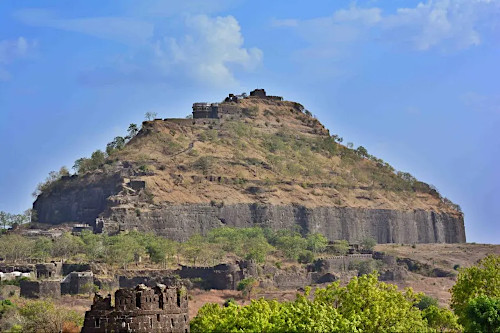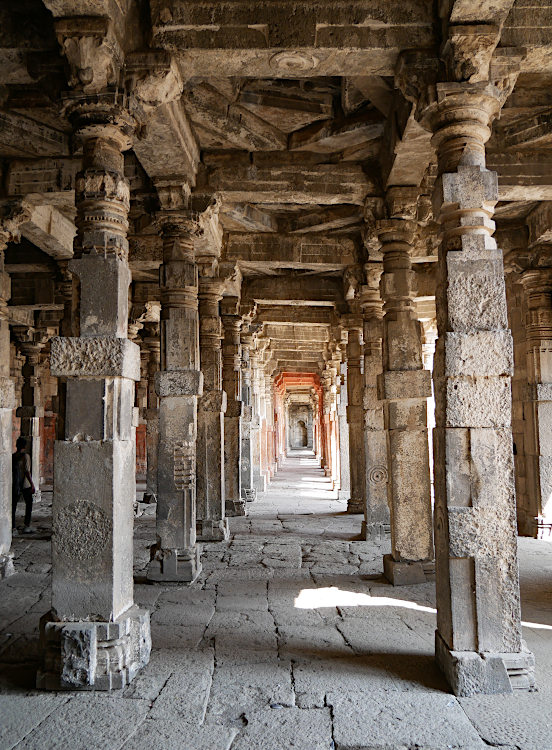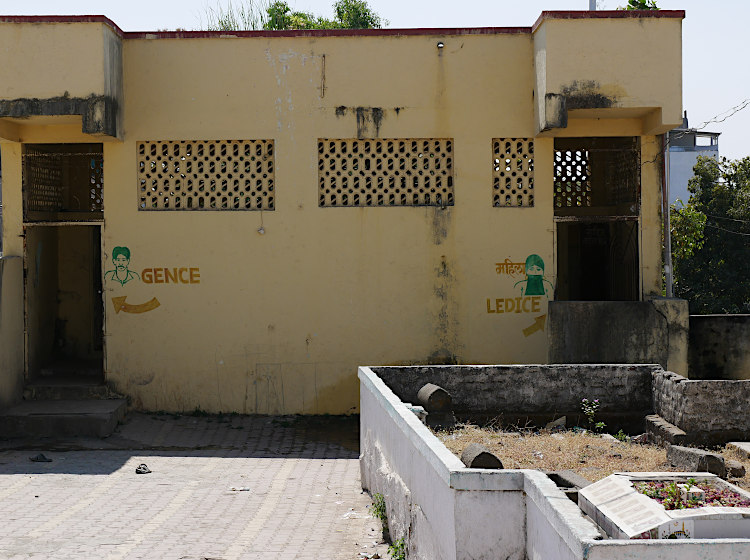
Indomitable fortress and a pilgrimage
After exploring the Ajanta caves in the morning, I took a couple of buses and was dropped off at my next destination: Hotel Kailas, Ellora (2,800Rs). The hotel is very handily placed right outside the gate to the Ellora caves but I wasn’t going to squeeze in two World Heritage Sites in one day, I chilled in the afternoon after a very tasty okra curry (bhindi masala) because I was up first thing in the morning again, for two slightly different experiences: The ancient fortress of Daulatabad and nearby pilgrimage site of Khuldabad.
Wed 12th Feb 2025
Another early start for me, as it usually is, to beat the heat and the other tourists, especially those pesky school kid groups! Daulatabad fort is on the main road between Ellora and Aurangabad so a public bus soon arrived and whisked me to my destination. I wasn’t sure what time it opened (different sources told different things as they often do) but it was certainly open by the time I arrived at 8 along with a phalanx of sweepers. They didn’t need to stop off at the ticket office however, or pay the foreigner fee of 300Rs. According to the literature, Daulatabad is one of India’s most remarkable examples of military architecture. It is certainly striking from a distance, perched inaccessibly on top of a huge unscalable rock that rises from the plains. The rock maybe unscalable but fortunately, its builders, the Yadavas in the 11th Century, excavated a tunnel through the rock to reach the upper levels. The parts perched on this rock are actually only a small part of the whole fort. The rock is surrounded by a moat which is in turn surrounded by other fortifications known as the Kalakot. Beyond this are a further set of fortifications known as the Mahakot, this is where the majority of the other buildings are. The fortifications themselves stretch for 2.5kms. As you can see from the map below, the entrance is at the south. I decided to get to the top first while it was still cool and then explore the other areas later.

After the ticket window, you pass a series of gates to enter the main fort (Mahakot)

And then it’s a long straight walk, past the Chand Minar (victory tower)

To the gates of the Kalakot


Within this section are a few decrepit buildings such as the Chini Mahal, the Chinese Palace, so named because of the few remaining Chinese tiles adorning the walls.

Then it’s across the moat and into the underground passage. Most guidebooks say that the passage is very dark and has bats, however, they have recently cleaned it up and installed lights.

Which emerges through a trapdoor.

Perched on top of the hill is the Baradari, the stone palace built by Shah Jahan of Taj Mahal fame.

With great views of the fort and the surrounding countryside.


Back down into the Mahakot

And into the great mosque (1319). This was built by the first invading Muslims with the remnants of the original Yadava Hindu temples as can be seen from the carved columns.



Of course, now it has been reclaimed as a Hindu temple, the Bharat Mata Temple, which is the mother goddess of India, depicted below here in the original mihrab.






So after my explorations, time for a light lunch. I had to have probably the most popular dish in Maharashtra and not found much elsewhere: a pav bhaji. Interestingly the pav comes from the Portuguese “pau” meaning bread and probably originates from when they were here also naming Bombay as Bom: beautiful, Baía: bay

My day wasn’t done however as nearby is another top spot and major pilgrimage site for many Muslims: Khuldabad. It’s now a rather scruffy village with many old buildings from medieval times including walls and gateways. But in the 14th century many Sufi saints chose to reside here and so it contains their shrines or dargahs. One of them was the spiritual guide of Aurangzeb, the last of the great Mogul Emperors. In contrast to his predecessors who have magnificent tombs, he chose to be buried next to his mentor and stipulated that his simple grave should be open to the sky and have no embellishments. For me personally, it was fascinating as I had visited the magnificent tombs of Humayun, Akbar and of course Shah Jehan who is entombed at the Taj Mahal





When I entered the dargah, I was immediately greeted by a blind man who showed me to the tomb and gave me a potted history of Aurangzeb, for a small donation. He also showed me to a locked room. Apparently inside was a piece of Mohamed’s (Yes, THE Mohamed) robe. It is shown once a year on his birthday.


Also seen inside the complex. Not sacred but quite interesting. I didn’t investigate further.

Nagarkhana Gate (1700)


Just outside Khuldabad are some more tombs, the most famous of which belongs to Malik Ambar, who was ruler of the Ahmednagar Sultanate in the 1400s. A very interesting character, he started off as a slave in Abyssinia before rising through the ranks in Medieval India. He is also credited with building Janjira fort which I was to visit later in this trip.


There are a number of less well preserved tombs in the area as well. Including this sorry looking one.

It was now getting rather hot so I got a three wheeler back to the hotel, showered and ready for another meal. This time channa (chickpea) masala. Funnily enough I had been noticing fields of chickpeas in the area and in the local markets. It must have been harvest time. A plant I had never noticed before.

More photos of Daulatabad and Khuldabad here
Map of 2025 trip: